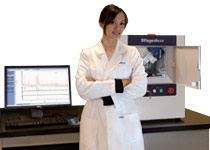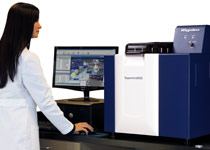| MiniFlex – qualitative and quantitative analysis of polycrystalline materials |
 |
| Benchtop X-ray diffraction (XRD) instrument |
Ideally suited for today's fast-paced XRD analyses, the fifth generation MiniFlex delivers speed and sensitivity through innovative technology enhancements such as the optional D/teX high speed detector coupled with a 600 W X-ray source. Whether used for teaching X-ray diffraction at the college and university level, or routine industrial quality assurance, the MiniFlex delivers both performance and value.
For more > |
|
| High-power Benchtop Sequential WDXRF Spectrometer |
 |
| Supermini200 – Elemental analysis of solids, liquids, powders, alloys and thin films |
| As the world's only high-power benchtop sequential wavelength dispersive X-ray fluorescence (WDXRF) spectrometer for elemental analysis of oxygen (O) through uranium (U) of almost any material, the Rigaku Supermini200 uniquely delivers low cost-of-ownership (COO) with high resolution and lower limits-of-detection (LLD).
For more > |
|
| Wizard Classic |
 |
| Crystallization screen series |
Rigaku Reagents' Wizard Classic screens were designed to increase the probability of producing crystals during the coarse screening crystallization trials of biological macromolecules. Wizard Classic screens offer a large range of crystallants, buffers, and salts covering a broad range of crystallization space at pH levels from pH 4.5 to pH 10.5. They are proven to be a highly effective starting point for screening, with non-repeating formulations. Each of these screens is offered in either a 96 deep well block plate format or in 10 ml tubes.
For more > |
|
| Video of the Month |
 |
JACOB BRONOWSKI
The Ascent of Man |
| British mathematician Jacob Bronowski's 1973 BBC television series received high acclaim for highly informed but eloquently simple analysis, his long unscripted monologues and its extensive location shoots. In the series' 13 episodes, Bronowski traveled around the world in order to trace the development of human society through its understanding of science.
Watch the video > |
|
| Conferences and Workshops |
 |
Join Rigaku
at future meetings |
Rigaku will be sponsoring, attending or exhibiting at the following conferences and trade shows:
CBRN First Response
Bristol, UK
January 26 – 27, 2016
PITTCON
Atlanta, GA, USA
March 6 – 10, 2016
ACS – Spring
San Diego, CA, USA
March 13 – 17, 2016
See the complete list >
|
|
| Useful link of the Month |
 |
| XMI-MSIM |
| XMI-MSIM is an open source tool designed for predicting the spectral response of energy-dispersive X-ray fluorescence (EDXRF) spectrometers using Monte Carlo simulations. It comes with a fully functional graphical user interface in order to make it as user friendly as possible. Considerable effort has been taken to ensure easy installation on all major platforms. XMI-MSIM is released under the terms of the GPLv3.
For more >
|
|
| Planning to Submit a Grant? |
 |
| Rigaku is happy to assist |
| If you are planning on submitting an instrument grant proposal, Rigaku will be happy to assist you. We can help you determine the correct instrument and configuration best suited for your analytical needs.
Start the process >
|
|
| Rigaku's Materials Analysis eNewsletter, The Bridge |
 |
| Join us |
| Each month, Rigaku distributes two eNewsletters: The Bridge, which focuses on Materials Analysis, and Crystallography Times, which concentrates on life sciences.
Register >
|
|
|
|
Welcome
This month's issue of The Bridge is being sent out early on account of the Christmas and New Year's holidays over the next two weeks. In the coming months, Rigaku will attend many major international events. A revised listing of Rigaku events may be found on our web site.
Rigaku Analytical Devices handheld Raman analyzer wins the R&D 100 award. This prestigious award recognized Progeny™ ResQ™ as one of the 100 most innovative products of 2015 by R&D magazine.
As many of you may know, Rigaku's single crystal X-ray diffraction has become Rigaku Oxford Diffraction with the recent acquisition. Dr. Paul Swepston explains the acquisition and their mission is this article. Also, the new ultra-fast structure determination and structure solution tools in CrysAlisPro v38 software are explained in a new poster. A few photos of the ROD stand at the recent ECM meeting are shown below.

For your continuing education, we offer the fourth installment of our new series "Introduction to single crystal X-ray analysis," entitled "Some Key Points of Structure Analysis by Rigaku's CrystalStructure." Our featured technical paper is a primer on "X-ray Thin-film Measurement Techniques: Out-of-plane diffraction measurements."
To amuse and delight, this month's video is a trailer for Jacob Bronowski's seminal TV series "The Ascent of Man." For those who did not see it in the 1970's on BBC (also PBS or CBC), it is eye opening. Some episodes are available online. Check out the news and papers sections at the bottom of the page for the latest developments in materials science. Enjoy the newsletter.
R.C. Tisdale, Ph.D. – Editor
 |
|
Featured XRD Rigaku Journal Article
X-ray Thin-film Measurement Techniques II
Rigaku Corporation
A thin-film sample is two-dimensionally formed on the surface of a substrate, and the film thickness is usually very small, about 1µm or less. It can be difficult to use a conventional powder diffractometer to acquire high-quality diffraction data from a thin film because
thin-film diffraction peaks are usually weak, and the background intensities caused by diffraction and scattering from the substrate are very high. It is known that preferred orientation or anisotropic lattice distortion can have a strong effect on physical properties of thin films, so that it is indispensable to reveal structural or textural properties of thin films using X-ray diffraction techniques with proper X-ray optics. For more > |
 |
|
XRD Application Note – 1
Evaluation of the temperature dependence of a lattice constant using an infrared heating high-temperature attachment and a parallel beam optical system
Rigaku Corporation
Using X-ray diffraction, it is possible to identify crystal phases based on the crystalline structure of a material, and
evaluate factors such as lattice length, and atom coordinate positions. Therefore, X-ray diffractometry is an analytic
technique, which is essential for research on the properties of materials. Within diffractometry, X-ray diffraction
measurement under high temperatures is a powerful technique, which goes beyond the identification of material structure
and properties that are achieved with ordinary measurement. It enables examination of phase transitions and chemical
reactions, which occur under high temperatures, deterioration conditions and synthesis processes, and temperature
dependence of lattice constants. For more > |
 |
|
XRD Application Note – 2
Detection of minor peaks of iron-based samples using
the D/teX Ultra high-speed 1-dimensional detector
Rigaku Corporation
If a high-speed 1-dimensional detector is used, and comparison is done under measurement conditions with the same
resolution, it is possible to obtain an intensity approximately 100 times that of a scintillation counter (SC). However, if the
sample contains elements with a high mass-absorption coefficient for the X-ray wavelength used, then there will be a
major increase in the background due to fluorescent X-rays. The D/teX Ultra high-speed 1-dimensional detector has high
energy resolution, and can greatly reduce the rise in background due to fluorescent X-rays from the sample by narrowing
the detected energy range.
For more > |
 |
|
XRD Application Note – 3
Molecular orientation of stretched rubber
Rigaku Corporation
Diffraction patterns of stretched rubber differ between the machine direction (MD) and the transverse direction (TD), as
the molecules orient themselves according to the tensile direction. Since XRD measurements using 0D or 1D detectors
perform scans targeting only a part of a diffraction ring, it can be difficult to obtain diffraction patterns because of the
arrangement of the molecules. In contrast, with XRD measurements using a 2D detector, diffraction patterns are gained
from 360° in one measurement, making it easy to identify the molecular orientation of a sample. For more > |
 |
|
WDXRF Application Note
Quantitative Analysis of Low Alloy Steel using the Supermini200
Rigaku Corporation
X-ray fluorescence spectrometers are the most common analysis tools to analyze steel owing to rapid analysis and the ability to measure both bulk metal and powders. This application note describes low alloy steel analysis using the Supermini200, which is optimized for process control. For more > |
 |
|
EDXRF Application Note
Sulfur in Fuel
Applied Rigaku Technologies
On-line monitoring of the sulfur content of fuels in the refining
or blending process is a critical step in insuring the end
product meets specifications. Continuous monitoring allows
for process optimization and minimizes lab testing
requirements. The Rigaku NEX OL offers a simple and low
maintenance on-line analytical technique for trending your
processes.
For more > |
 |
|
Raman Application Note
Detection of Munitions Grade Chemical Warfare
AGENTS Using Handheld Raman
Rigaku Raman Technologies
History shows that chemical warfare agents (CWAs) are
the most widely proliferated and used weapons of mass
destruction (WMD). Unlike ultrapure laboratory grade
chemicals, munitions grade CWAs used in these attacks
are likely to contain impurities from the storage container,
degradation, or unreacted precursors, all of which often cause
fluorescence when analyzed using 785nm based detection systems. In order to minimize
fluorescence in these types of real world threats, Progeny ResQ uses a longer wavelength
(1064nm) laser, which leads to more reliable identifications and short measurement times. For more > |
 |
|
Scientific Book Review
Computed Tomography: Principles, Design, Artifacts and Recent Advances,
Third Edition By Jiang Hsieh
You might wonder why I chose this book for the December review. In October, I received a list of new publications from the Society of Photo-Optical Instrumentation Engineers (SPIE) at about the same time as the nano3DX and CTLab systems were installed in the applications lab here in The Woodlands. Since I have not found a satisfactory text on X-ray microcomputed tomography, I thought this book might be a good substitute, since many of the principles associated with medical CT are the same.
For more > |
 |
|
Material Analysis in the News
News for December 2015
December 1, 2015. A team of material scientists in the United States has discovered a novel allotrope of carbon, Q-carbon. Nucleation of microdiamond from nanodiamond filaments which were quenched after the formation at 6,740 degrees Fahrenheit. Q-carbon is distinct from graphite and diamond. The only place it may be found in the natural world would be possibly in the core of some planets, according to team leader Prof. Jagdish Narayan, of North Carolina State University.
December 3, 2015. Researchers at Chiang Mai University and the National Nanotechnology Center in Thailand, and the University of Wollongong in Australia, have come up with one-step method using microwaves to make BiVO4 nanoparticles that doesn't require high temperatures and pressures.
December 7, 2015. According to the Japan Aerospace Exploration Agency (JAXA), the Akatsuki space probe has succeeded in entering an orbit around the planet Venus. Akatsuki was designed by JAXA's Institute of Space and Astronautical Science (ISAS) to peel away some of the mystery of the dense and cloudy atmosphere.
December 7, 2015. Cornell researchers have uncovered the process by which mollusks manufacture nacre – commonly known as "mother of pearl." Images with nanometer-scale resolution revealed that the organism builds nacre by depositing a series of layers of a material containing nanoparticles of calcium carbonate. Moving from the inside out, these particles are seen coming together in rows and fusing into flat crystals laminated between layers of organic material.
December 7, 2015. Oxford University scientists are creating the world's most expensive material – endohedral fullerenes, spherical carbon molecules containing nitrogen atoms, which sell for £200 million a gram. The tiny structures are being manufactured by a company which was born out of the university last year.
December 9, 2015. A new class of superhydrophobic nanomaterials might simplify the process of protecting surfaces from water. A material made by scientists at Rice University (led by Rice chemist Andrew Barron), the University of Swansea, the University of Bristol and the University of Nice Sophia Antipolis is inexpensive, nontoxic and can be applied to a variety of surfaces via spray- or spin-coating.
December 11, 2015. Berkeley Lab researchers have developed a freeze-casting technique that enables them to design and create strong, tough and lightweight materials comparable to bones, teeth, shells and wood. The bidirectional freeze-casting technique could provide an effective way of manufacturing novel structural materials, in particular advanced materials such as composites.
December 15, 2015. The National Academy of Inventors (NAI) has named 168 leaders of invention and innovation to Fellow status. Those named today bring the total number of NAI Fellows to 582, representing over 190 research universities and governmental and non-profit research institutes. The 2015 Fellows account for 5,368 issued U.S. patents, bringing the collective patents held by all NAI Fellows to more than 20,000.
December 16, 2015. Organic semiconductor materials are already being employed today in solar cells and organic LEDs (OLEDs) amongst others. Until now, however, little was known about how the doping molecules are integrated into the chemical structure of organic semiconductors. The Molecular Systems Joint Research Team of the Helmholtz-Zentrum Berlin and Humboldt-Universität zu Berlin at BESSY II have now analyzed this with surprising results.
December 16, 2015. Chemical industry giants Dow Chemical and DuPont are to merge in a $130 billion (£86 billion) deal. The merged company will then split, spawning three independent publicly traded companies in agrichemicals, materials science and speciality products.
|
 |
|
Recent Scientific Papers of Interest
Papers for December 2015
Recent Scientific Papers of Interest is a monthly compilation of material analysis papers appearing in recently released journals and publications. See below |
An Inquiry-Based Project Focused on the X-ray Powder Diffraction Analysis of Common Household Solids. Hulien, Molly L.; Lekse, Jonathan W.; Rosmus, Kimberly A.; Devlin, Kasey P.; Glenn, Jennifer R.; Wisneski, Stephen D.; Wildfong, Peter; Lake, Charles H.; MacNeil, Joseph H.; Aitken, Jennifer A. Journal of Chemical Education. Dec2015, Vol. 92 Issue 12, p2152-2156. 5p. DOI: 10.1021/acs.jchemed.5b00008.
Stochastic algorithms for solving linear and nonlinear inverse ill-posed problems for particle size retrieving and x-ray diffraction analysis of epitaxial films. Sabelfeld, Karl K.; Mozartova, Nadezhda S. Journal of Inverse & Ill-Posed Problems. Dec2015, Vol. 23 Issue 6, p673-686. 14p. DOI: 10.1515/jiip-2015-0043.
Element Analysis Based on Energy-Dispersive X-Ray Fluorescence. Yao, Min; Wang, Dongyue; Zhao, Min. Advances in Materials Science & Engineering. 12/1/2015, p1-7. 7p. DOI: 10.1155/2015/290593.
X-ray diffraction study of spontaneous strain in the iron-based superconductor Sr4V2Fe2As2O6-δ. Saito, Masahiro; Fujishita, Hideshi; Okamoto, Hiroyuki; Kobayashi, Yoshiaki; Sato, Masatoshi. Physica C. Dec2015, Vol. 519, p142-146. 5p. DOI: 10.1016/j.physc.2015.08.014.
Probing diffusion of In and Ga in CuInSe2/CuGaSe2 bilayer thin films by x-ray diffraction. Namnuan, B.; Yoodee, K.; Chatraphorn, S. Journal of Crystal Growth. Dec2015, Vol. 432, p24-32. 9p. DOI: 10.1016/j.jcrysgro.2015.09.010.
Fine-tuning the theoretically predicted structure of MIL-47(V) with the aid of powder X-ray diffraction. Bogaerts, Thomas; Vanduyfhuys, Louis; Vanpoucke, Danny E. P.; Wieme, Jelle; Waroquier, Michel; Van Der Voort, Pascal; Van Speybroeck, Veronique. CrystEngComm. 12/7/2015, Vol. 17 Issue 45, p8612-8622. 11p. DOI: 10.1039/c5ce01388g.
Pore development during gasification of South African inertinite-rich chars evaluated using small angle X-ray scattering. Coetzee, G. Hennie; Sakurovs, Richard; Neomagus, Hein W.J.P.; Morpeth, Leigh; Everson, Raymond C.; Mathews, Jonathan P.; Bunt, John R. Carbon. Dec2015, Vol. 95, p250-260. 11p. DOI: 10.1016/j.carbon.2015.08.030.
Atomic layer deposition to prevent metal transfer from implants: An X-ray fluorescence study. Bilo, Fabjola; Borgese, Laura; Prost, Josef; Rauwolf, Mirjam; Turyanskaya, Anna; Wobrauschek, Peter; Kregsamer, Peter; Streli, Christina; Pazzaglia, Ugo; Depero, Laura E. Applied Surface Science. Dec2015, Vol. 359, p215-220. 6p. DOI: 10.1016/j.apsusc.2015.09.248
X-ray fluorescence analysis based on the modified standard-background procedure in the system of analytical control of solid-phase products of metallurgical precious metal products. Bakhtiarov, A.; Savel'ev, S.; Zaitsev, V.; Devitsina, O.; Chuprina, S.; Sapunov, R. Inorganic Materials. Dec2015, Vol. 51 Issue 14, p1423-1430. 8p. DOI: 10.1134/S0020168515140034.
Special tablets containing cellulose binder and Sr internal standard for simplifying X-ray fluorescence analysis of powder samples. Mzyk, Zofia; Anyszkiewicz, Jacek; Gorewoda, Tadeusz. Spectrochimica Acta Part B. Dec2015, Vol. 114, p15-19. 5p. DOI: 10.1016/j.sab.2015.09.011.
X-ray fluorescence holography studies for a Cu3Au crystal. Dabrowski, K.M.; Dul, D.T.; Jaworska-Golab, T.; Rysz, J.; Korecki, P. Nuclear Instruments & Methods in Physics Research Section B. Dec2015, Vol. 364, p136-141. 6p. DOI: 10.1016/j.nimb.2015.05.035.
Simultaneous determination of the elemental composition and ash content of carbon materials by total reflection X-ray fluorescence. Alov, N.; Sharanov, P. Journal of Analytical Chemistry. Dec2015, Vol. 70 Issue 12, p1480-1487. 8p. DOI: 10.1134/S1061934815120023.
L shell fluorescence yields and total ionization and x-ray production cross sections for elements with 40≤Z≤92. Bendjedi, A.; Deghfel, B.; Kahoul, A.; Derradj, I.; Khalfallah, F.; Sahnoune, Y.; Bentabet, A.; Nekkab, M. Radiation Physics & Chemistry. Dec2015, Vol. 117, p128-134. 7p. DOI: 10.1016/j.radphyschem.2015.08.008.
Combined optic system based on polycapillary X-ray optics and single-bounce monocapillary optics for focusing X-rays from a conventional laboratory X-ray source. Sun, Xuepeng; Liu, Zhiguo; Sun, Tianxi; Yi, Longtao; Sun, Weiyuan; Li, Fangzuo; Jiang, Bowen; Ma, Yongzhong; Ding, Xunliang. Nuclear Instruments & Methods in Physics Research Section A. Dec2015, Vol. 802, p5-9. 5p. DOI: 10.1016/j.nima.2015.08.043.
Qualitative and quantitative insights into multiphase flow in ceramic sponges using X-ray computed tomography. Wallenstein, M.; Hafen, N.; Heinzmann, H.; Schug, S.; Arlt, W.; Kind, M.; Dietrich, B. Chemical Engineering Science. Dec2015, Vol. 138, p118-127. 10p. DOI: 10.1016/j.ces.2015.08.015.
Significance of pore percolation to drive anisotropic effects of 3D printed polymers revealed with X-ray μ-tomography and finite element computation. Guessasma, Sofiane; Belhabib, Sofiane; Nouri, Hedi. Polymer. Dec2015, Vol. 81, p29-36. 8p. DOI: 10.1016/j.polymer.2015.10.041.
Interior strain analysis of a woven composite beam using X-ray computed tomography and digital volumetric speckle photography. Mao, Lingtao; Chiang, Fu-pen. Composite Structures. Dec2015, Vol. 134, p782-788. 7p. DOI: 10.1016/j.compstruct.2015.08.129.
Different Methods for Determining Porosity of Gas Diffusion Layer using X-ray Microtomography. Hasanpour, S.; Hoorfar, M.; Phillion, A.B. Electrochimica Acta. Dec2015, Vol. 185, p34-39. 6p. DOI: 10.1016/j.electacta.2015.10.083.
X-ray tomography investigation of intensive sheared Al–SiC metal matrix composites. De Giovanni, Mario; Warnett, Jason M.; Williams, Mark A.; Haribabu, Nadendla; Srirangam, Prakash. Materials Characterization. Dec2015, Vol. 110, p258-263. 6p. DOI: 10.1016/j.matchar.2015.11.003.
|




















